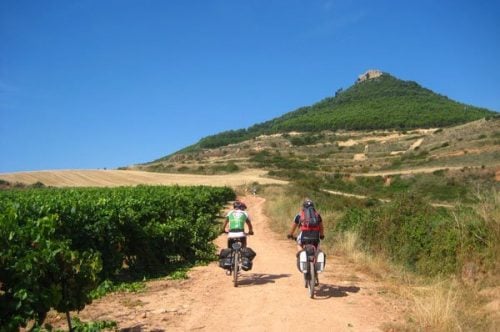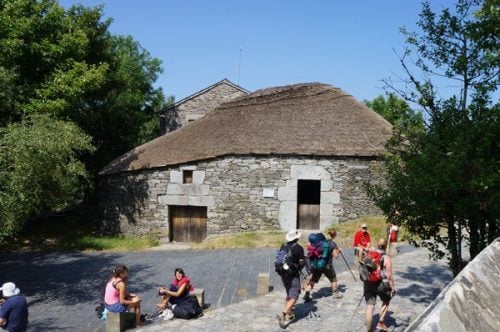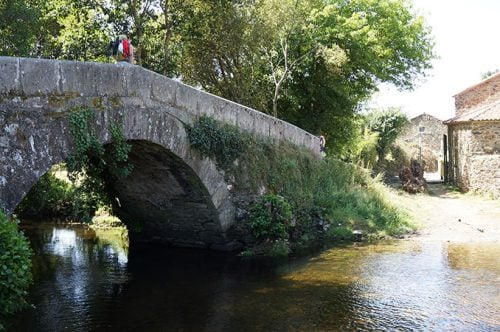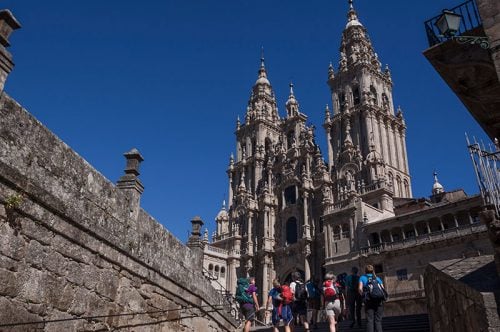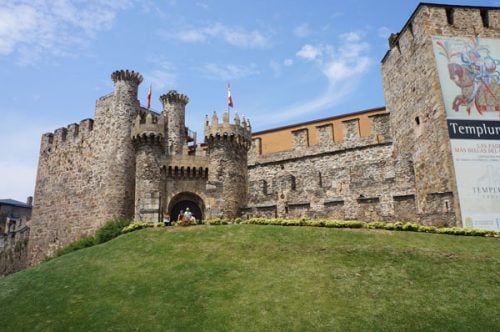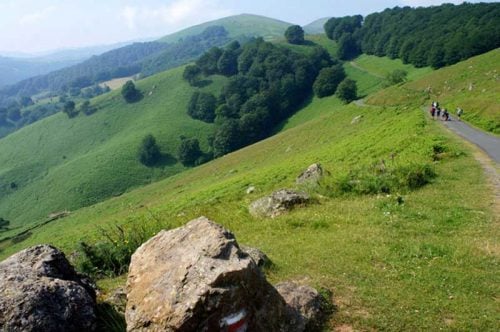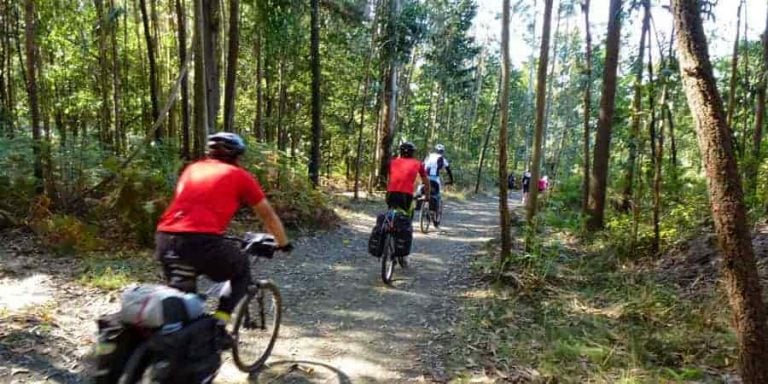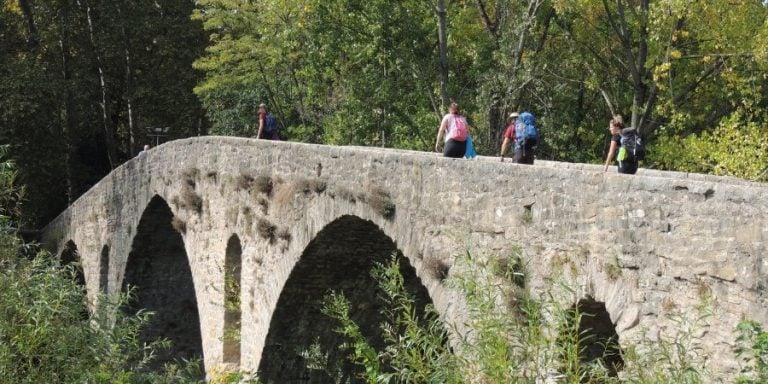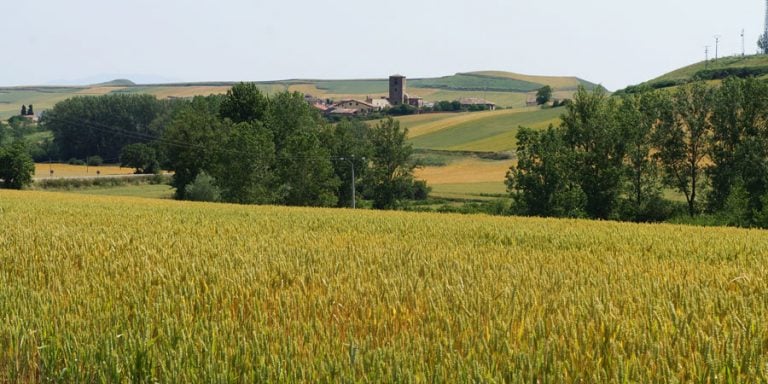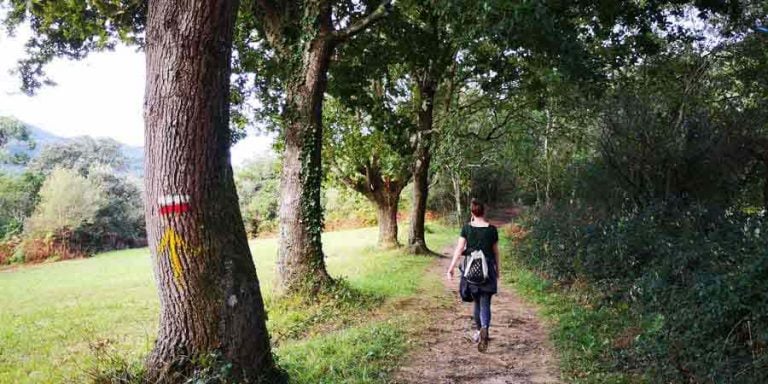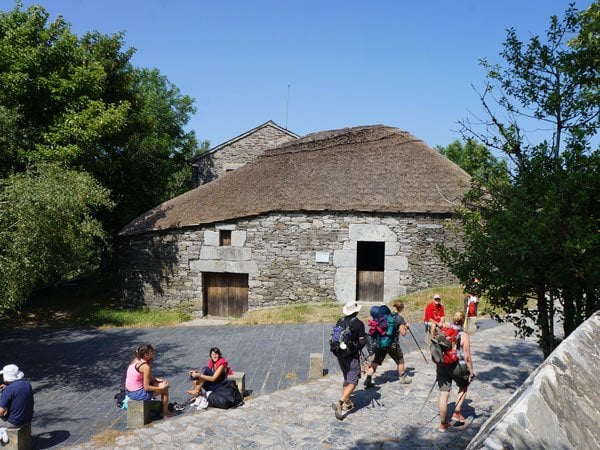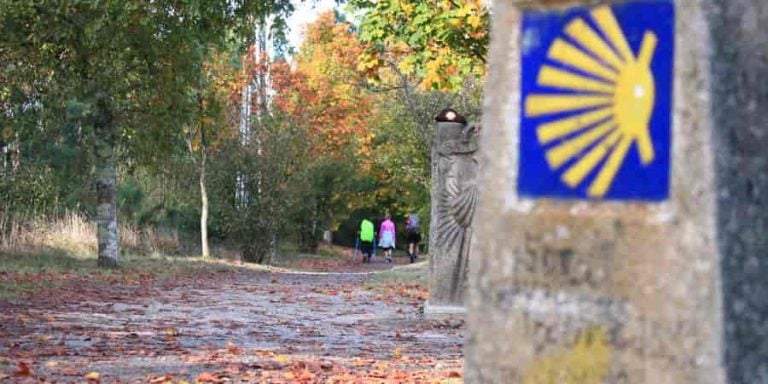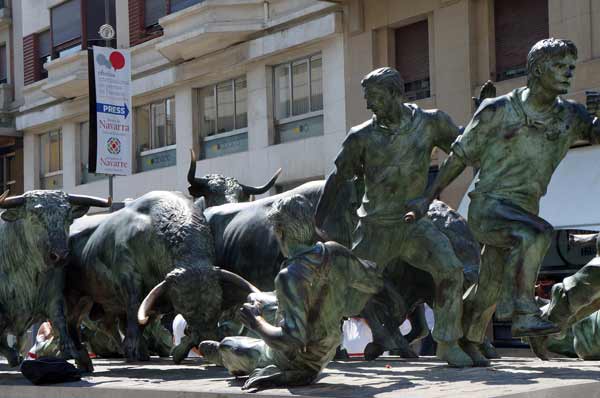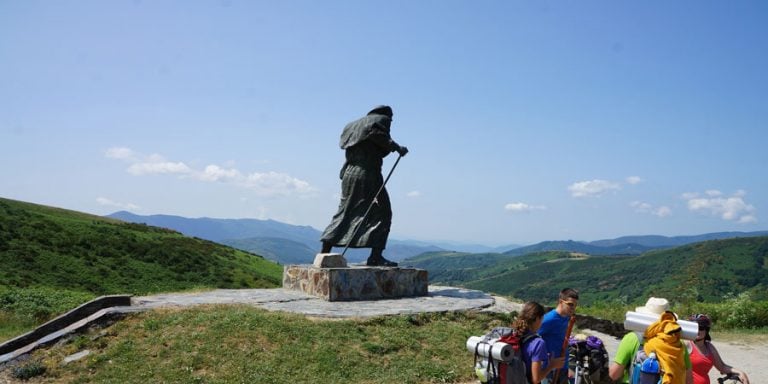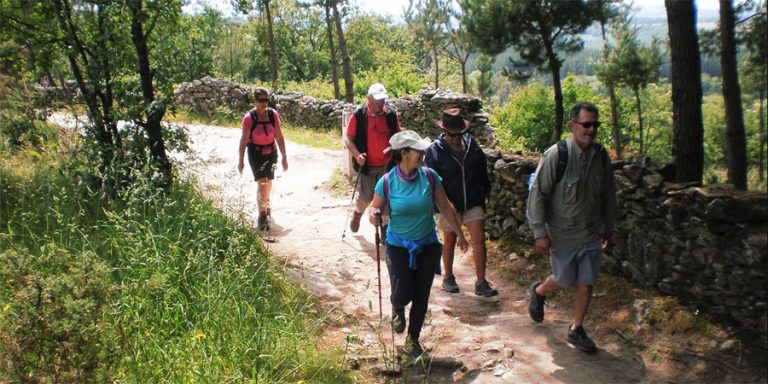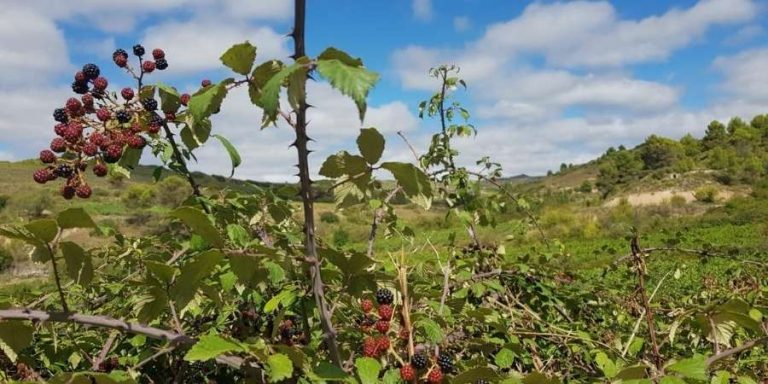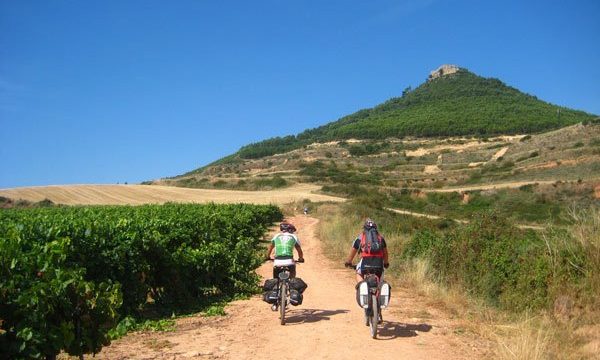The Camino Frances
The Camino Francés, also known as the French Way, is the most famous of the Camino de Santiago routes. People usually refer to this specific route when speaking about the Camino.
This iconic route has been featured in many books and films, including the popular movie ‘The Way’ starring Martin Sheen. The touching documentary ‘I’ll Push You‘ also highlights this path, beautifully showcasing the strength of friendship and shared determination.
The Camino Francés is an ancient pilgrimage route beginning in Saint-Jean-Pied-de-Port, a picturesque town in southern France. It ends in Santiago de Compostela, a sacred Spanish city where the Cathedral is believed to house St. James’s remains.
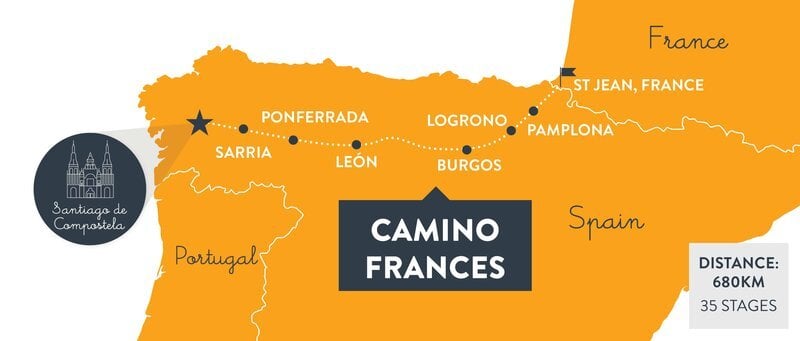
The Camino Francés is rich in attractions, offering a journey through stunning cities and natural landscapes. Highlights include Pamplona, famous for its bull run; the La Rioja wine region and its capital, Logroño; the impressive cathedral in Burgos; the elegant city of León; and Ponferrada with its historic Templar Castle. As the route continues from Ponferrada, it enters Galicia, passing through the mountains and the charming village of O Cebreiro.
The most popular section is the final 100km of the Camino Francés, starting in Sarria and ending in Santiago. This part of the route is ideal for those looking for a social experience or first-time pilgrims, as the sense of camaraderie is particularly strong on the French Way.
The Camino de Santiago is internationally recognised as a symbol of European unity. In 1987, the Council of Europe designated it as the first European Cultural Route. The Camino, along with its architectural treasures, is also listed as a UNESCO World Heritage Site.
Suggested Routes
Highlights Of The Camino Francés
• Discover beautiful cities and charming medieval towns along the French Way, such as St-Jean-Pied-de-Port, Pamplona, Logroño, Burgos, Leon, Ponferrada, and Sarria.
• Take time out to explore the wonderful old town of Santiago de Compostela.
• The Camino Francés boasts stunning landscapes, From the Pyrenees and the vineyards of La Rioja to the vast open spaces of the Meseta and the rugged mountains of León and O Cebreiro.
• Walk over the peaceful hills of rural Galicia on the last 100km of the Camino Francés from Sarria.
• Walk in La Rioja’s vineyards and sample some of the very best wines on the French Camino from Logroño.
If you are up for the ultimate challenge, you can walk the full Camino Francés, 790km, in over a month (35 nights), or you can choose to walk different sections of the French Way for as little as a week or two at a time. Discover more about the Camino Francés on our blog. You can also contact us for any help and advice.
Getting The Compostela Certificate on The Camino Francés
While the Camino from Saint-Jean-Pied-de-Port is very popular, most pilgrims start their Camino journey from the town of Sarria, in Galicia. This is mainly because you will need to walk at least the last 100km of a route (and stamp your pilgrim passport along the way!) to receive your Compostela pilgrim certificate in Santiago. This is also the most social part of the route, where you will meet many fellow pilgrims and find the real spirit and camaraderie of the Camino de Santiago, the Way of St James.
For those cycling the Camino and wishing to receive the certificate, the minimum distance is 200km, so you must at least complete your Camino cycling from Ponferrada to get it. It should only take you one week to complete.
Camino Ways Route Planner
For over 1000 years, pilgrims worldwide have walked the Camino Ways across Europe in their quest for spirituality. Making the pilgrimage to Santiago de Compostela in Spain, they encountered a variety of people, cultures, and beliefs, leading to friendship and new experiences. This continues today, with the Camino de Santiago being the most well-known and well-loved walk in the world. More than just a walk, the Camino de Santiago is an unforgettable and unique journey for the body, mind, and soul.
When To Go On The Camino Francés
The French Way has 3 types of weather:
- The first part of the Camino Francés, from Saint-Jean-Pied-de-Port to Pamplona, crosses the Pyrenees, where snow can block the path from November to March. In Rabanal (after Astorga) and O Cebreiro, snow can also linger until March.
- The Meseta, the stretch between Logroño and Astorga, is a hot, dry plateau where summer temperatures often reach 40°C in July and August.
- Galicia, including the last 100km from Sarria to Santiago, is beautiful year-round. However, from mid-November to early March, it can be wet and cold, with temperatures around 5 to 10°C. In summer, the average temperature is a comfortable 25°C. Despite this, spring and autumn remain the most popular times to walk due to the pleasant weather.
The Terrain On The French Way
Aside from three challenging days (Saint-Jean to Roncesvalles, Rabanal to Ponferrada, and Villafranca to O Cebreiro), the Camino Francés is relatively easy. The main challenge is maintaining the fitness level required to walk an average of 20km per day.
The daily ascent and descent are around 400m, which is manageable and not too demanding compared to other treks like the GR20 or TMB, which involve 1500 to 2000m each day.
The Camino Francés is a mix of dirt tracks (50%) and quiet country roads (50%). It never runs along busy roads or highways, offering a traditional countryside experience.
What To Bring On The Camino Francés?
Our Camino packing guide ebook is free to download. This will help you decide what to bring on your Camino.
The Sections Of The Camino Frances
This is the complete itinerary for the traditional stages of the French Way, also known as the Camino Francés. Please note that the list does not include’ split days’.
St-Jean-Pied-de-Port to Pamplona
The first section of the French Way starts in St-Jean-Pied-de-Port in the French Basque Country and crosses the Pyrenees, finishing in the city of Pamplona, world-famous for its Bull Run, San Fermín. This is one of the most challenging but beautiful parts, especially if you take the ‘Napoleon Route’ over the Roncesvalles Pass (1450m). The views of the Pyrenees are worth the effort! Over 20,000 pilgrims choose to start their ‘way’ to Santiago de Compostela in St. Jean each year, covering nearly 800km across the north of Spain.
Pamplona to Logroño
This section of the Way of St James starts in the city of Pamplona (Iruña in Basque), famous for its San Fermín Bull Run festival, on the 7th of July every year. The section finishes in Logroño, the capital of the La Rioja wine region and a fantastic city to discover authentic Spanish tapas. From the pilgrim sculpture at Alto del Perdón, you will enjoy panoramic views of Pamplona behind and the vast countryside ahead before continuing on your way. On this section of the Camino, you will walk across the mountains of Navarra and La Rioja vineyards, passing medieval bridges, castles, churches, and picturesque villages along the way, such as Puente de la Reina, Cirauqui, Estella-Lizarra and Viana. Stop at Bodegas Irache and the Wine Museum for a rest and a quick sip at the free wine fountain.
Logroño to Burgos
Logroño to Burgos continues along the French Way starts in Logroño, the capital of the famous Rioja wine region. Explore the city and treat yourself to ‘tapas’ in the lively Calle del Laurel before you start your journey. The terrain becomes easier than in previous stages of the Camino, and you will walk sections across undulating farmland and vineyards, passing castles, monasteries and charming villages. One of the highlights is Santo Domingo de la Calzada and its historic centre, an important stop for pilgrims “on the Camino since the Middle Ages. You will finish your walk in the majestic city of Burgos, home of ‘El Cid’, where you should visit its magnificent cathedral, possibly the most beautiful in Spain.
Burgos to León
This section of the Camino starts in majestic Burgos, the hometown of ‘El Cid’ and considered the Gothic capital of Spain. This section of the French Way finishes in the village of Sahagún, in the heart of the Meseta, with its vast, wide-open landscapes. The sounds of nature and endless crop fields will be your companions for this section of the Camino de Santiago, dotted with hamlets, picturesque sleepy villages and Romanesque churches. Then, starting in the medieval town of Sahagún, section 5 of the Camino de Santiago along the French Way will take you across the Meseta, the immense Castilian Plateau (900m) and its villages. You will finish this walking section in León, where you can admire the cathedral, the remains of its Roman walls, the Romanesque Royal Basilica of Saint Isidoro and Gaudí’s neo-Gothic Casa de Botines.
León to Ponferrada
Section 6 of the Camino de Santiago along the French Way (Camino Francés) starts in the lively city of León and finishes in Ponferrada, built by the Templars in the 12th century. Along the way, you will pass the hilltop city of Astorga, famous for its chocolates and other sweet delicacies. After Astorga, you will ascend to the spectacular and unscathed León Mountains (Montes de León), passing rustic mountain villages and hamlets before reaching the El Bierzo region. Your destination for this Camino section is Ponferrada, the capital of the El Bierzo region and the last city before Santiago de Compostela.
Ponferrada to Sarria
This section of the Camino de Santiago runs along the French Way (Camino Frances) starts in Ponferrada, with its imposing Templars Castle, and finishes in the market town of Sarria, the most popular Camino starting point. You will begin your journey heading to Villafranca del Bierzo, a gorgeous town surrounded by idyllic countryside. After Villafranca, a challenging ascent will lead to the mountains of O Cebreiro. You will enter Galicia via O Cebreiro, a stunning mountain village in a region of outstanding natural beauty. After O Cebreiro, the Camino will continue along forest tracks towards Sarria, just over 100km from Santiago. An alternative route will take you by the impressive Samos Monastery.
Sarria to Santiago
This is the most popular walking tour of the Camino de Santiago from Sarria. Perfect for those looking to capture the essence of the Camino: a nice walk, good food and wine, discovering local customs, meeting fellow pilgrims and enjoying the unique atmosphere of it all. You won’t forget a single minute of it! This section of the Camino de Santiago starts in Sarria and covers the last 100km of the Camino Frances, the minimum required to apply for your Compostela certificate. The Camino will take you across woodlands, farmland and rustic hamlets, following tracks and paths lined by granite stone walls. The green rolling landscape.
History Of The Camino Francés
The Camino Francés, or French Way, is the most well-known and traditional route to Santiago de Compostela. It became internationally famous through the film The Way, starring Martin Sheen, which highlights the journey’s emotional and spiritual appeal. The trail was first established in the late 11th century by monarchs who supported its development and promotion across the region.
Royal Support and Historical Development
Kings like Sancho III the Greater and Sancho Ramírez of Navarra y Aragón played key roles in shaping the Camino Francés. Alphonse VI and his successors also promoted and maintained the route, ensuring pilgrims could walk safely towards Santiago. Their efforts helped transform the path into one of Europe’s most important spiritual and cultural pilgrimages.
The Codex Calixtinus – A Medieval Guidebook
The Codex Calixtinus is a vital 12th-century manuscript offering detailed information about the pilgrimage to Santiago. Book V of the Codex is considered the first-ever pilgrim guidebook written for those walking the Camino Francés. It outlines the path from France through Spain, including notes on food, hospitality, landmarks, and local customs.
Pilgrim Information and Religious Purpose
The guide is attributed to Aymeric Picaud, a French cleric who travelled and documented the route for fellow pilgrims. His writing reflects both the religious goals and political motivations behind promoting Santiago as a major Christian destination. The Codex was an essential tool for Medieval pilgrims, providing clear and practical directions for their spiritual journey.
The Height of Pilgrimage Popularity
During the 12th century, the Camino Francés reached its peak as pilgrims arrived from across the Christian world.
One Muslim ambassador even noted how crowded the roads were with travellers walking westward to Santiago de Compostela. The route held great importance, uniting people through shared faith and a common destination.
Decline and Modern Rediscovery
Political and religious conflicts in Europe led to a decline in pilgrimage numbers during later centuries. It was not until the 19th century that renewed interest in Saint James and the Camino began to grow again. In the 20th century, restoration efforts—especially those of Elias Valiña, priest of O Cebreiro—revived the route’s popularity and cultural significance.
